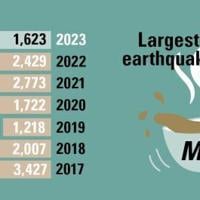Yellowstone Caldera Chronicles is a weekly column written by scientists and collaborators of the Yellowstone Volcano Observatory. This week’s contribution is from David Shelly, seismologist with the U.S. Geological Survey.
When an earthquake occurs, usually the first characteristics reported are the event’s location and magnitude. But with a little more analysis, we can often use the earthquake to obtain information about the orientation of the source fault and the direction of slip on that fault.
The fault orientation and the slip direction of an earthquake are described by something called a focal mechanism. And focal mechanisms are usually visualized by what are called “beachball” diagrams. These diagrams are circles with various shading that form arcs across the circle — hence the beachball nickname.
People are also reading…
Examples of earthquake focal mechanisms and their associated fault displacements. “P” and “T” indicate the pressure and tension axes, respectively, associated with the fault motion of each focal mechanism.
Beachball diagrams can be confusing, but with a bit of explanation and experience, anyone can use them to better understand the characteristics of an earthquake. These diagrams describe the earthquake “focalsphere” — a sphere containing the fault that slipped in an earthquake. Depending on the orientation from which seismic waves leave the source, the initial motion of the wave can be compressional (usually shown as black or gray quadrants in the beachball) or tensional (usually shown as white in the beachball). And depending on where seismic stations are located at the surface relative to the earthquake, they receive waves from different parts of this focalsphere. Some stations will feel a push (compression) as the first part of an earthquake wave, while other stations will feel a pull (tension).
Depending on the size of an earthquake, seismologists use different methods to determine focal mechanisms. For moderate to large earthquakes (usually magnitude 3.5–4.0 and larger, depending on the seismic network quality and noise levels), seismologists can model the earthquake source and fit the long-period (~10 s period or greater) ground motion records recorded at multiple locations. This is called a moment tensor.
But smaller earthquakes don’t generate sufficient low-frequency energy to effectively use this technique, and we usually don’t know the earth structure in sufficient detail to compute moment tensors using high-frequency seismic waves. Because of this, focal mechanisms of small earthquakes are usually computed based primarily on the direction of observed motion of the first-arriving earthquake wave. As mentioned earlier, this motion can either be compressional (upwards, or away from the source), or tensional (downwards, or back toward the source). If we have a dense local seismic network, these observations can be combined to determine the focal mechanism. But if there aren’t enough seismic stations, or the earthquake was too small to be clearly recorded on a lot of stations, it might not be possible to determine a focal mechanism.
Once we’ve computed a focal mechanism, we know the exact orientation of the fault plane, right? Unfortunately, through a cruel twist of physics, each focal mechanism has two possible fault orientations. One of these is the fault plane, and the other, which is perpendicular to the fault plane, is termed the “auxiliary plane.” Earthquakes with either orientation produce nearly identical seismic waves, so to distinguish the fault plane from the auxiliary plane we need additional information. Sometimes we use alignments of multiple earthquake locations or analysis of the direction of rupture to distinguish the fault plane from the auxiliary plane, or we can determine the fault plane based on an understanding of the stress field for the region. By the same token, the stress field can also be estimated through analysis of many focal mechanisms (but that’s a subject for another time).
Our discussion so far assumes that an earthquake occurs on a single planar fault. These are called “double-couple” events. But is nature always that simple? Of course not! Although this is a reasonable approximation for most earthquakes, we know that some earthquakes are more complicated. They can occur on non-planar faults, they can be generated by slip on multiple faults, or, especially at volcanoes, they can sometimes be generated by other processes altogether, such as the growth and collapse of bubbles. In those cases, earthquakes may be determined to be “non-double-couple” events, and their beachball representations can become less beachball-like.
The main point is that beachball diagrams can be a challenge to derive from seismic data, but they also provide important information about how and why a fault slips in an earthquake.
So what about focal mechanisms in Yellowstone? Although there are a few exceptions, most Yellowstone earthquakes are well approximated by this “double-couple” model. They are mostly due to “normal” faulting (which is caused by extension, including a vertical component, and is common throughout the western U.S.), with some “strike-slip” (horizontal motion) events. In fact, two of the largest recorded earthquakes in the region, the 1959 M7.3 Hebgen Lake earthquake and the 1975 M6 Norris Junction earthquake were both primarily normal faulting events.
So, next time you’re at the beach and discussing earthquakes (most people talk about earthquakes when they’re at the beach, right?), feel free to impress your friends by grabbing the nearest inflatable beachball and teaching them about focal mechanisms and earthquake faulting.





